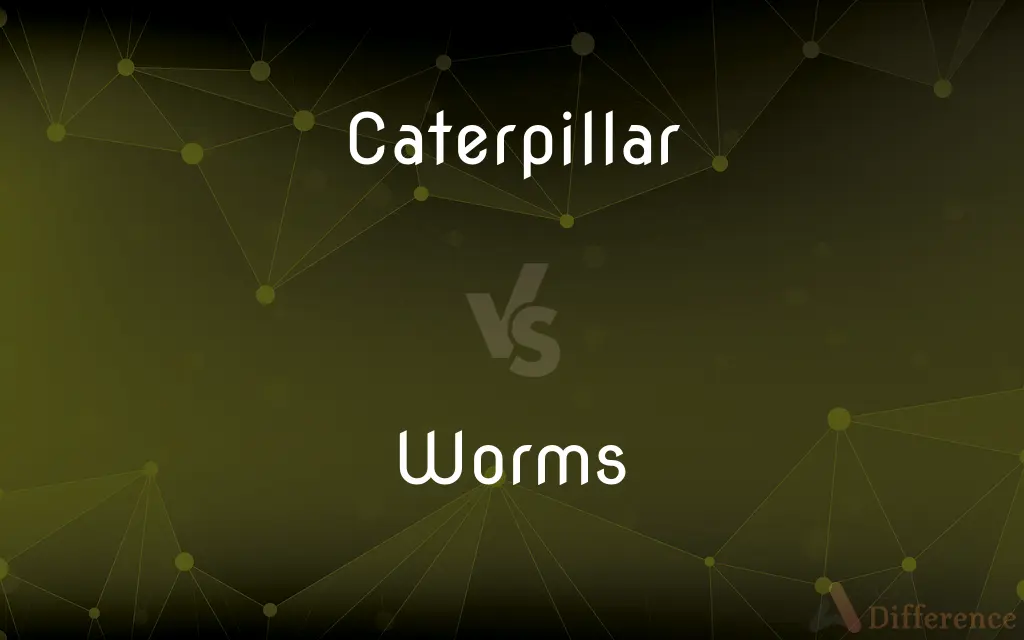Caterpillar vs. Worms — What's the Difference?
By Tayyaba Rehman & Maham Liaqat — Updated on April 20, 2024
Caterpillars are specific larval stages of butterflies or moths, specialized for feeding; worms, including earthworms, are elongated, soft-bodied invertebrates with diverse roles in ecosystems.

Difference Between Caterpillar and Worms
Table of Contents
ADVERTISEMENT
Key Differences
Caterpillars are the larval stage of members of the order Lepidoptera, primarily feeding on leaves to gather energy for metamorphosis, whereas worms can refer to numerous unrelated invertebrate species, such as earthworms, which play crucial roles in soil aeration and composting.
Caterpillars undergo a complete metamorphosis, transforming dramatically into butterflies or moths, while many worms do not undergo significant metamorphic changes and live relatively consistent life stages.
Most caterpillars are herbivores, consuming large amounts of foliage, which can sometimes classify them as pests in agricultural settings, on the other hand, worms like earthworms are detritivores, feeding on decomposing plant and animal material, and are generally regarded as beneficial to soil health.
Caterpillars are often brightly colored or have distinct markings as a deterrent to predators, whereas many worms have simple, unadorned bodies suited to their underground or aquatic lifestyles.
In terms of human interaction, caterpillars are sometimes reared deliberately for silk production or as part of butterfly gardening, whereas worms are often used in vermiculture and as bait in fishing.
ADVERTISEMENT
Comparison Chart
Taxonomic Classification
Larvae of butterflies and moths (Lepidoptera)
Various invertebrate groups (e.g., annelids, nematodes)
Habitat
Mainly on plants
Soil, freshwater, marine environments
Role in Ecosystem
Herbivores, prey for other species
Soil aeration, decomposition, prey and predator
Body Features
Often colorful, with protective markings
Generally elongated, cylindrical, lack distinct features
Human Use
Silk production, biological studies
Vermiculture, fishing bait
Compare with Definitions
Caterpillar
Herbivorous and known for rapid growth.
Caterpillars must eat continuously to grow large enough to pupate.
Worms
Includes species like earthworms, nematodes, and annelids.
Marine worms play a critical role in ocean ecosystems.
Caterpillar
Often brightly colored as a warning or camouflage.
The swallowtail caterpillar disguises itself as bird droppings.
Worms
Some species are used in fishing bait.
Anglers often use red worms as bait for freshwater fishing.
Caterpillar
A larval stage of butterflies and moths.
The monarch caterpillar feeds exclusively on milkweed.
Worms
Diverse group of elongated, soft-bodied invertebrates.
Earthworms are vital for healthy soil.
Caterpillar
Undergoes metamorphosis into a butterfly or moth.
After pupating, the caterpillar emerges as a fully formed moth.
Worms
Often live in soil or water.
Tubifex worms thrive in sediment at the bottom of lakes.
Caterpillar
Can be a pest in agriculture.
The gypsy moth caterpillar is notorious for defoliating trees.
Worms
Play roles in decomposition and nutrient cycling.
Worms break down organic matter, enriching the soil.
Caterpillar
Caterpillars ( CAT-ər-pil-ər) are the larval stage of members of the order Lepidoptera (the insect order comprising butterflies and moths). As with most common names, the application of the word is arbitrary, since the larvae of sawflies are commonly called caterpillars as well.
Worms
Plural of worm
Caterpillar
The wormlike larva of a butterfly or moth.
Caterpillar
Any of various insect larvae similar to those of the butterfly or moth.
Caterpillar
The larva of a butterfly or moth; leafworm
The bird just ate that green caterpillar.
Caterpillar
A vehicle with a caterpillar track; a crawler
Caterpillar
(maths) A set of subtrees of a tree
Caterpillar
The larval state of a butterfly or any lepidopterous insect; sometimes, but less commonly, the larval state of other insects, as the sawflies, which are also called false caterpillars. The true caterpillars have three pairs of true legs, and several pairs of abdominal fleshy legs (prolegs) armed with hooks. Some are hairy, others naked. They usually feed on leaves, fruit, and succulent vegetables, being often very destructive, Many of them are popularly called worms, as the cutworm, cankerworm, army worm, cotton worm, silkworm.
Caterpillar
A plant of the genus Scorpiurus, with pods resembling caterpillars.
Caterpillar
A wormlike and often brightly colored and hairy or spiny larva of a butterfly or moth
Caterpillar
A large vehicle that is driven by caterpillar tracks; frequently used for moving earth in construction and farm work
Common Curiosities
Can worms be harmful?
Some worms, like certain parasitic nematodes, can be harmful to plants, animals, and humans.
What do caterpillars eat?
Caterpillars primarily eat plant leaves, but some species may eat other parts of plants or even different caterpillars.
Are all caterpillars colorful?
Many caterpillars are colorful, which can serve as camouflage or a warning to predators, but not all are.
How do worms help the environment?
Worms improve soil structure, enhance nutrient cycling, and help with the decomposition of organic material.
How do caterpillars turn into butterflies?
Caterpillars pupate, undergoing metamorphosis inside a cocoon or chrysalis, eventually emerging as butterflies or moths.
What is the lifespan of a caterpillar?
The lifespan of a caterpillar varies but generally lasts a few weeks to months, depending on the species.
Do all worms live in soil?
No, worms inhabit various environments, including marine and freshwater bodies.
How do caterpillars defend themselves?
Many caterpillars use camouflage, mimicry, or toxic chemicals to deter predators.
How do environmental changes affect caterpillars?
Changes like habitat loss and climate change can affect caterpillar populations, impacting their survival and metamorphosis.
Do worms have eyes?
Most worms do not have eyes; instead, they sense the environment through their skin and other sensory organs.
What types of worms are there?
There are many types, including earthworms, flatworms, and roundworms, each adapted to different environmental niches.
What's the difference between a caterpillar and a worm?
Caterpillars are specific larval forms of butterflies and moths, while "worm" is a broad term for many unrelated invertebrate species.
What are the ecological roles of worms?
Worms contribute to nutrient cycling, soil fertility, and are part of many food webs.
Share Your Discovery

Previous Comparison
Close vs. Seal
Next Comparison
Weaned vs. WeenedAuthor Spotlight
Written by
Tayyaba RehmanTayyaba Rehman is a distinguished writer, currently serving as a primary contributor to askdifference.com. As a researcher in semantics and etymology, Tayyaba's passion for the complexity of languages and their distinctions has found a perfect home on the platform. Tayyaba delves into the intricacies of language, distinguishing between commonly confused words and phrases, thereby providing clarity for readers worldwide.
Co-written by
Maham Liaqat













































